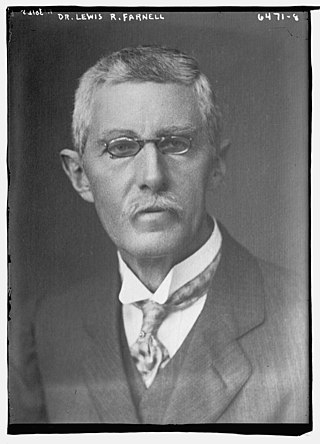
Papyrus is a material similar to thick paper that was used in ancient times as a writing surface. It was made from the pith of the papyrus plant, Cyperus papyrus, a wetland sedge. Papyrus can also refer to a document written on sheets of such material, joined side by side and rolled up into a scroll, an early form of a book.

The Rosetta Stone is a stele of granodiorite inscribed with three versions of a decree issued in Memphis, Egypt, in 196 BC during the Ptolemaic dynasty on behalf of King Ptolemy V Epiphanes. The top and middle texts are in Ancient Egyptian using hieroglyphic and Demotic scripts, respectively, while the bottom is in Ancient Greek. The decree has only minor differences between the three versions, making the Rosetta Stone key to deciphering the Egyptian scripts.

Andrew Colin Renfrew, Baron Renfrew of Kaimsthorn, is a British archaeologist, paleolinguist and Conservative peer noted for his work on radiocarbon dating, the prehistory of languages, archaeogenetics, neuroarchaeology, and the prevention of looting at archaeological sites.

The Petrie Museum of Egyptian Archaeology in London is part of University College London Museums and Collections. The museum contains 80,000 objects, making it one of the world's largest collections of Egyptian and Sudanese material. It is designated under the Arts Council England Designation Scheme as being of "national and international importance".
The Edwards Professor of Egyptian Archaeology and Philology is a university professorial chair held at University College London.
Richard John Alexander Talbert is a British-American contemporary ancient historian and classicist on the faculty of the University of North Carolina at Chapel Hill, where he was William Rand Kenan, Jr., Professor of History and is currently Research Professor in charge of the Ancient World Mapping Center. Talbert is a leading scholar of ancient geography and ideas of space in the ancient Mediterranean world.

John Garstang was a British archaeologist of the Ancient Near East, especially Egypt, Sudan, Anatolia and the southern Levant. He was the younger brother of Professor Walter Garstang, FRS, a marine biologist and zoologist. Garstang is considered a pioneer in the development of scientific practices in archaeology as he kept detailed records of his excavations with extensive photographic records, which was a comparatively rare practice in early 20th-century archaeology.
Barry John Kemp, is an English archaeologist and Egyptologist. He is Professor Emeritus of Egyptology at the University of Cambridge and directing excavations at Amarna in Egypt. His widely renowned book Ancient Egypt: Anatomy of a Civilisation is a core text of Egyptology and many Ancient History courses.

Alan John Bayard Wace was an English archaeologist, best known for his excavations at the Bronze Age site of Mycenae in Greece. He served as director of the British School at Athens (BSA) between 1914 and 1923, and excavated widely in Thessaly, in Laconia and in Egypt. He was also an authority on Greek textiles and a prolific collector of Greek embroidery.
Carl Nicholas Reeves, FSA, is a British Egyptologist, archaeologist and museum curator.

Ancient Egyptian literature was written in the Egyptian language from ancient Egypt's pharaonic period until the end of Roman domination. It represents the oldest corpus of Egyptian literature. Along with Sumerian literature, it is considered the world's earliest literature.

Jack L. Davis is Carl W. Blegen Professor of Greek Archaeology at the University of Cincinnati in Ohio and is a former Director of the American School of Classical Studies at Athens.
Malcolm H. Wiener is an Aegean prehistorian, retired principal in an investment management firm, and philanthropist. He is a natural-born American citizen, born in Qingdao, China. He is married to Carolyn Talbot Seely Wiener, with whom he has four children.

Lewis Richard Farnell FBA (1856–1934) was a classical scholar and Oxford academic, where he served as Vice-Chancellor from 1920 to 1923.
Percy Edward Newberry was a British Egyptologist.
Hans-Werner Fischer-Elfert is a German professor of Egyptology at the Institut für Ägyptologie, University of Leipzig, Germany. He received his Ph.D, written under the direction of Prof. Wolfgang Helck, from the University of Hamburg. He notably took part in the writing of the Lexikon der Ägyptologie. His researches focus on ancient Egyptian literature, religion, medicine and magic.
Ludwig David Morenz is German professor in Egyptology at the University of Bonn. He received his Ph.D. from the University of Leipzig and Habilitation from the University of Tübingen. His fields of research include the origins of Egyptian writing, Ancient Egyptian literature, ancient Egyptian society, and Renaissance and Baroque-era European studies on ancient Egypt. His current focus of research is exploring various levels of economic dependencies of Cannanites in relation to Egypt, that is not limited to slaves or illiterate workforce.

Arnold Walter Lawrence was a British authority on classical sculpture and architecture. He was Laurence Professor of Classical Archaeology at Cambridge University in the 1940s, and in the early 1950s in Accra he founded what later became the Ghana Museums and Monuments Board as well as the National Museum of Ghana. He was the youngest brother of T. E. Lawrence and his literary executor.
Robert George Morkot, FSA is an archaeologist and academic, specialising in Ancient Egypt. He is a Senior Lecturer in Archaeology at the University of Exeter. His current research is focused on the external relations of Ancient Egypt, particularly the relations with Kush (Sudan). He also works on the historiography of Ancient Egypt.
John Wintour Baldwin Barns was a British Egyptologist, papyrologist, Anglican priest, and academic. From 1965 to 1974, he was Professor of Egyptology at the University of Oxford.









